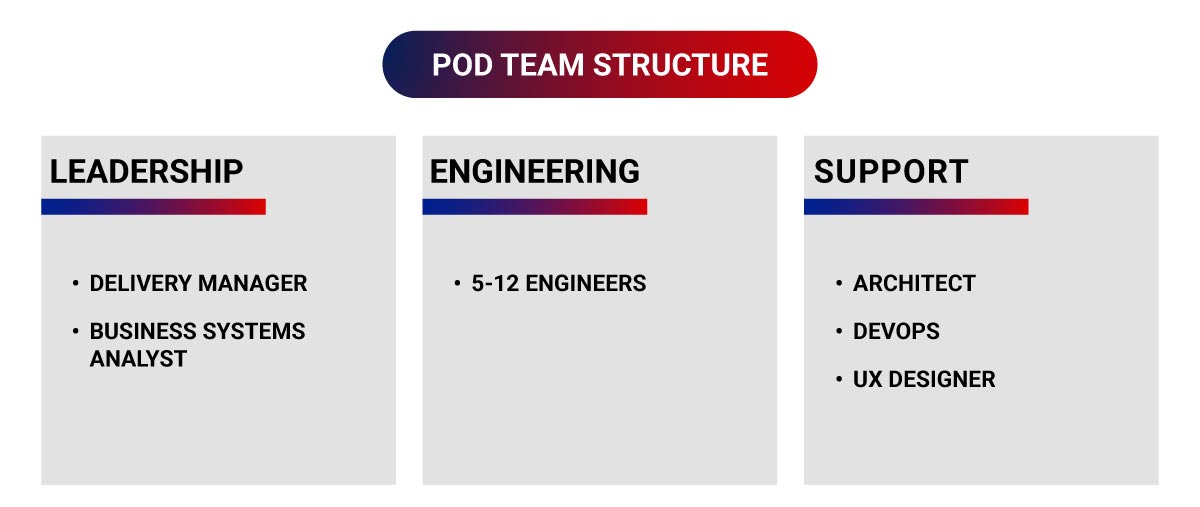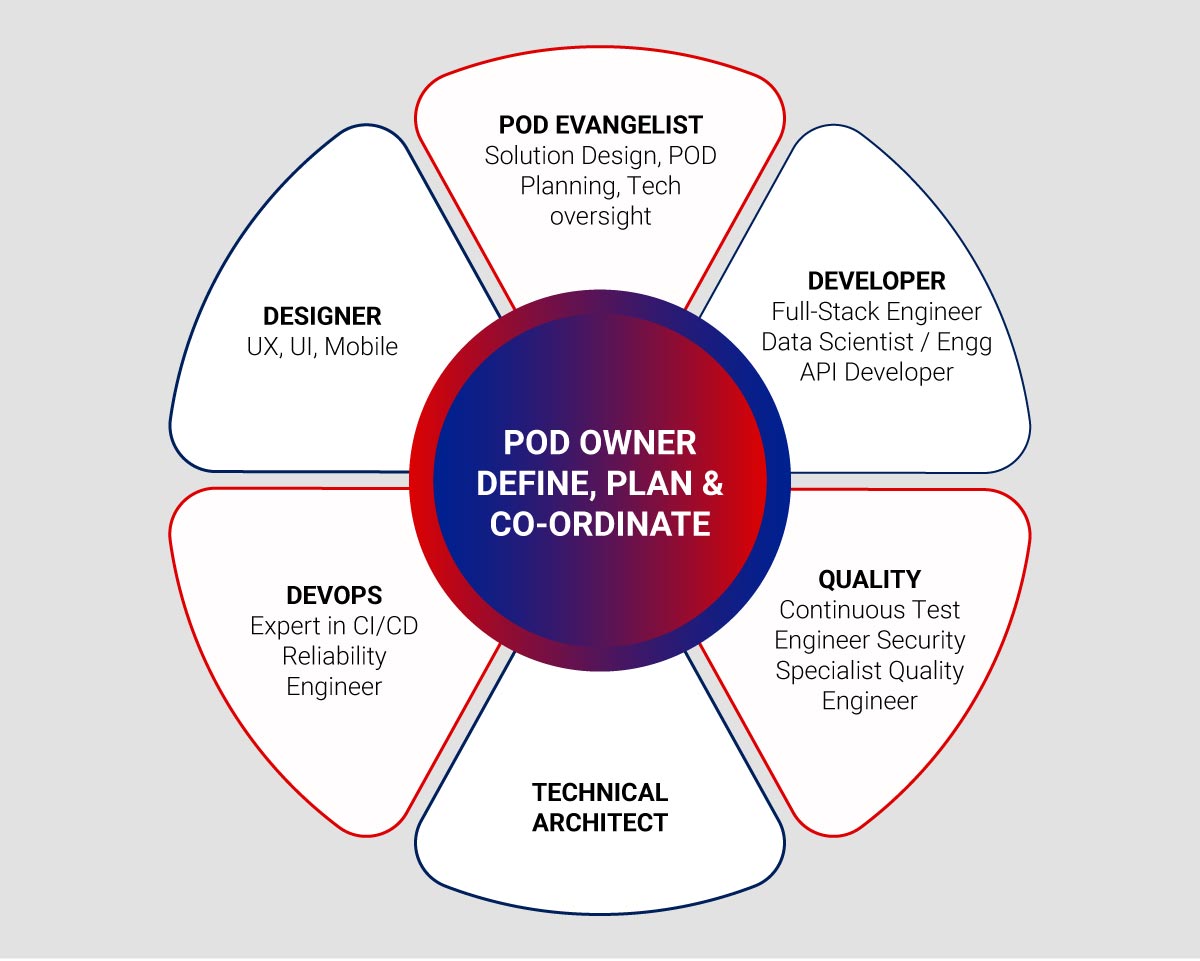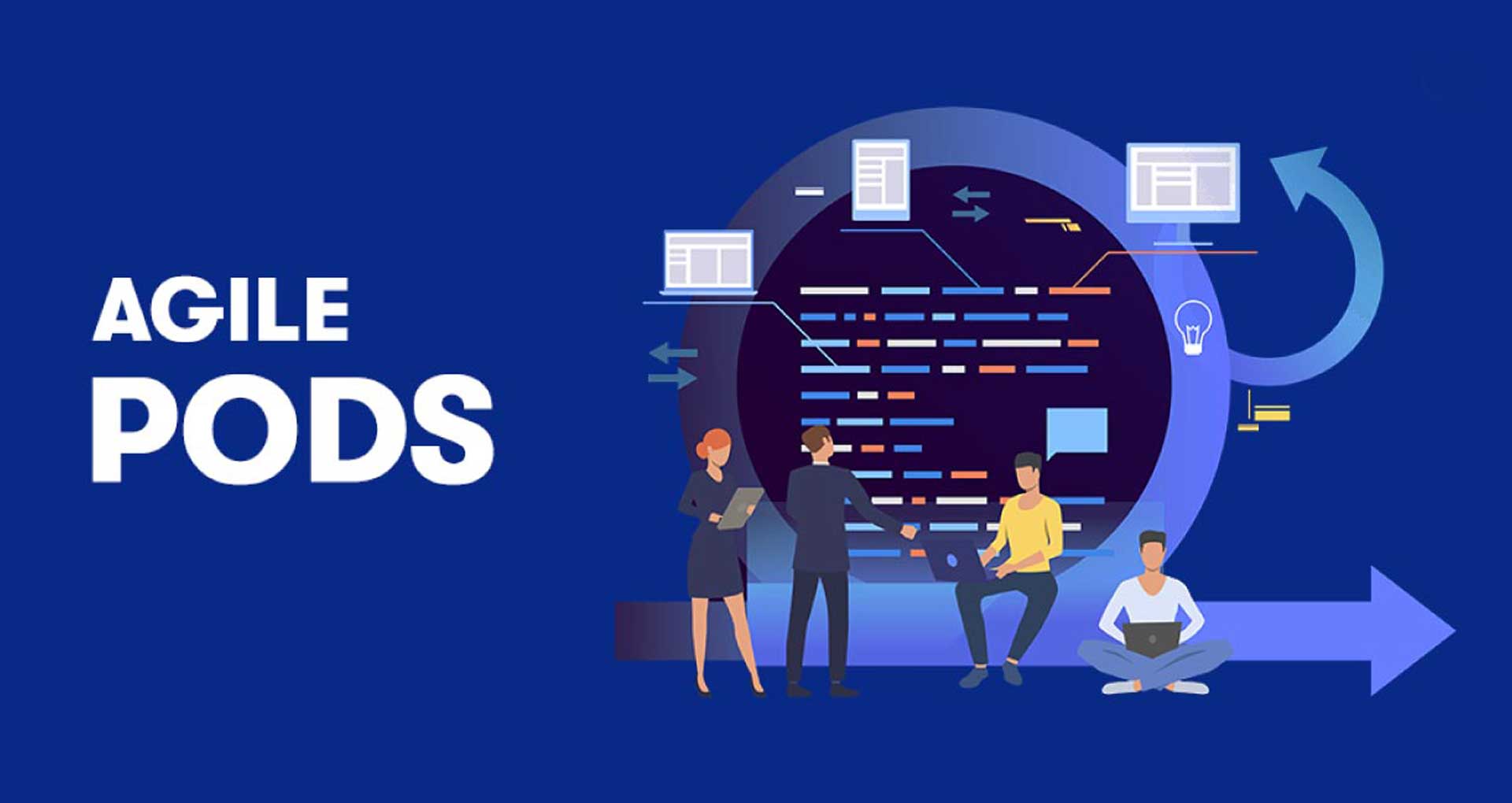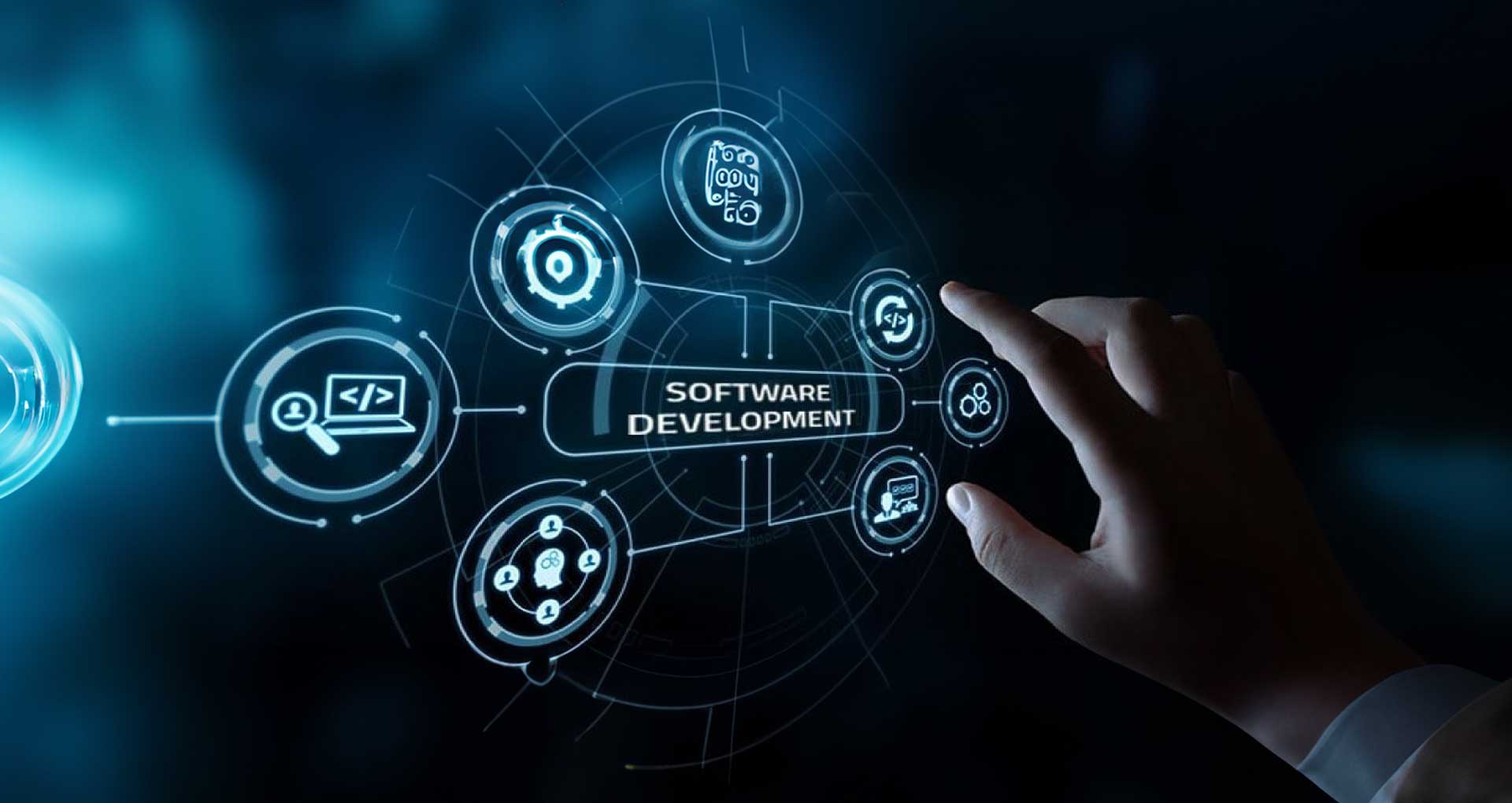Whether you’re a budding startup or a well-established enterprise, keeping up with the rapidly evolving IT market is crucial. Software product development teams are expected to become strategic partners that drive innovation, optimize processes, and deliver value quickly. To meet these expectations, they must embrace agility, prioritize customer satisfaction, boost quality, and foster transparency. And Agile Scrum has emerged as an excellent way to address it – especially when teams today work independently or on smaller projects. With larger engagements, the teams usually collaborate across globally recognized platforms – this is where the need for accountability & ownership is much needed. And that’s where the Agile Product Oriented Delivery (POD) delivery model comes into play.
Agile Pod is a work methodology originally derived from scrum though it has distinguishing aspects. This software engineering practice helps accelerate results, eliminates inefficient practices, maximizes development efficiency, and implements changes. It is while minimizing risks. So, if you’re ready to fast-track your software development efforts, reduce time to market, and delight your customers, it’s time to dive deeper into Agile Pods. Let’s explore how this model can transform how you develop and deliver software in customer engagement.
What is an Agile Pod?
An agile pod is a self-sufficient team with various competencies and skills to design, develop, test, and deploy a software product. Each pod is made up of team members with a set of complementary skills that are needed for swift and successful project delivery. A pod’s team members work collaboratively on the delivery of a defined product across multiple iterations. It would revolutionize software development by enabling teams to embrace agility, deliver value, and stay responsive in the face of evolving market demands.
Agile Pod Team Structure
It refers to a multi-disciplinary team consisting of both frontend & backend – engineers, designers, QA engineers, business analysts, and DevOps specialists. They bring their unique proficiencies with reusable solution accelerators & modern toolchains that enhance product development quality. They are led by an architect who wears the product owner hat. The pod team in agile focuses on autonomy, adaptability, and flexibility, empowering members to tackle challenges head-on.

However, it is crucial to understand agile pod methodology and its various roles & responsibilities that contribute to the effectiveness of project delivery.
Let’s discuss some of the crucial roles within the agile pod model:
- Leadership: Every successful development team is backed by visionary leadership. Typically, the product owner or delivery manager assumes this role. The pod leader is responsible for team management, client communication, agile processes, and product delivery. Their guidance ensures smooth operations and successful outcomes.
- Engineering: The team’s core comprises UI, back-end, and full-stack developers, along with a business analyst, test engineers, and QA specialists. This group is responsible for the planning, execution, and sustenance of the development process. It is possible to shuffle the team members between pods based on the required expertise, as needed.
- Support: The team incorporates part-time specialists that focus specifically on the delivery quality & value it offers. These specialists typically include architects, DevOps engineers, UX designers, a Scrum Master, or an Agile Coach. These specialists are brought in part-time and work concurrently with multiple Agile PODs and squads, providing valuable support.
By leveraging this well-defined team structure, companies can tap into diverse skill sets and maximize project success.
Traditional Teams vs. Agile Pod Teams – Which Model Is Right for Your Project?
There is often this debate about which model is right between – traditional & agile pod teams. Traditional and agile pod teams represent two distinct approaches to team structure and project management. While the former adheres to a hierarchical and sequential process, the latter embraces cross-functionality, collaboration, and iterative delivery.
Further, the two models differ regarding team structure, project planning and execution, communication and collaboration, ownership and accountability, and adaptability to change. Therefore, it is essential to understand the characteristics & nuances of each approach that can help determine the most suitable team structure to address specific projects & goals. And deciding on the right team structure is like choosing between the tried-and-true or venturing into new, unknown territory.
So let’s understand the key differences between traditional and agile pod teams to help you make an informed choice.
Team Structure
Traditional Teams:
Often have a hierarchical structure with clear functional roles, such as developers, testers, designers, and project managers. Team members work within their respective roles and may have limited interaction with other functions.Agile Pod Teams:
Are cross-functional, consisting of individuals with diverse skills & specialization necessary to deliver a complete feature or project. Pod members collaborate closely and collectively work on all aspects of feature development from start to finish.
Project Planning and Execution
Traditional Teams:
Typically follow a sequential or phased approach to project execution, where requirements are gathered upfront, followed by design, development, testing, and deployment phases. These phases are often distinct and separate, with little/no room for flexibility or change.Agile Pod Teams:
Work iteratively and incrementally, dividing the project into shorter time frames called sprints or iterations. They continuously plan, develop, test, and deliver small increments of working software within each iteration. It allows adaptability, feedback, and the ability to respond to changing requirements.
Communication and Collaboration
Traditional Teams:
Mainly formal and structured, with information flowing through established channels and hierarchical layers. Collaboration across functions may be limited, and communication tends to be top-down.Agile Pod Teams:
Prioritize frequent and open communication with daily stand-up meetings and constant collaboration initiatives are encouraged. Information is shared transparently, and decisions are made collectively within the team.
Ownership and Accountability
Traditional Teams:
Typically have clear role-based responsibilities and accountability. Team members are accountable for delivering their assigned tasks or components of the project.Agile Pod Teams:
Take collective ownership of the entire feature or project. They are accountable for the end-to-end delivery, including requirements gathering, development, testing, and deployment.
Adaptability to Change
Traditional Teams:
May struggle to adapt to changing requirements or priorities since the project plan is usually fixed and changes may require significant effort and coordination.Agile Pod Teams:
Designed to be adaptable & responsive to change. They embrace change as part of the process with mechanisms, such as backlog refinement and sprint planning, to accommodate evolving requirements or priorities.With over 20 years of technical capability, Rishabh Software can help you enhance your product development focus. Our cross-functional awareness ensures seamless collaboration between disciplines, resulting in accurate and fast decision-making.
Agile Pod Delivery Model Implementation Framework
With careful planning, practical implementation, and a focus on sustainability, agile pod teams can drive remarkable success in your organization. Here’s how:

Planning a POD
When assembling an agile pod team, bringing together a diverse range of IT roles is essential. Your pod should consist of SCRUM Masters, Product Leads, Technical/Business Analysts, Full Stack Developers, UX Designers, UI Developers DevOps Engineers, Test Engineers, QA Engineers, Cloud Engineers, and more. The team structure can include the pod leader, the core team, and part-time specialists.
POD Implementation
Once the roles are defined and the team is structured, it is time for executing the agile methodology. Clearly define responsibilities for each team member and prioritize flexibility. Actively collect feedback as your teams work to identify and address any pain points. Avoid an overlap between agile pods while focusing on the following:
- Key Features: Autonomous pods enable the implementation of specific features
- Team Capabilities: Consider the complexity of the product, technology stack, and future backlog and roadmaps when determining pod size and structure
- Resource Allocation: Embrace collaboration between teams, especially in remote work scenarios. Nearshore models can be advantageous, with developers from different regions sharing the same time zone.
Sustaining a POD
As your products evolve, multiple pods are created. To ensure their sustainability, define specific metrics and track them closely using the following approaches:
- KPIs: Measure the impact of your pod implementation through Key Performance Indicators (KPIs) such as pod velocity, sprint completion rate, and sprint burndown. These metrics provide actionable insights into progress and results.
- Pod Velocity refers to a measure of the amount of work. It is typically represented as user stories or story points, that a Scrum team completes during a specific time.
- Sprint Completion Rate provides insights into the team’s ability to deliver on their commitments and meet sprint goals. It helps identify trends and evaluate the team’s efficiency, effectiveness, and capacity.
- Sprint Burndown is a visual representation of the amount of work remaining in a sprint over time. It tracks the progress of the sprint by plotting the remaining effort (usually represented in story points or hours) on the y-axis and the sprint duration on the x-axis.
- Retrospectives: Encourage each pod to conduct independent retrospectives, analyzing what went well and areas for improvement. Sharing these findings with other pods will promote scalable continuous improvement.
Agile pod teams could be your answer if you’re looking to accelerate your software initiative, and time is of the essence. At Rishabh, we have sound experience creating dream teams that have delivered top-notch products in record time. So, if you’re ready to start your software development journey with a team that genuinely cares about your success, we’re here for you.
Dos and Don’ts While Working with Agile Pods
Before you start with the pod model framework, it’s crucial to understand a few dos and don’ts to ensure a smooth and successful experience.
Do’s:
- Prepare your team members for a seamless transition to agile pods by providing relevant training beforehand.
- During onboarding, invest time addressing any doubts or questions team members may have about the Agile pod framework.
- Ensure that team members’ skill sets complement one another when forming pods. Address any interpersonal issues beforehand to avoid friction or resistance within the team.
- Foster regular in-person or virtual meetings to enhance communication levels, even if your team is geographically dispersed.
- Establish a continuous learning process within the team, discussing takeaways and highlighting scenarios where being in a pod led to better and faster outcomes.
- Encourage sharing best practices between pod leaders, promoting an open learning environment.
- Leverage tools recommended by the team while paying attention to their suggestions for increased efficiency.
Don’ts:
- Understand that self-management is a concept that takes time to develop. Provide necessary guidance, especially to pod leaders.
- Avoid introducing new technology or tools midway through the process. Let the teams decide on the tools and techniques they need and allow them to achieve the best results.
- Refrain from micromanaging or interfering with the workings of the pod. Agile pods thrive on allowing team members to select tasks, resolve them, and deliver at their own pace. Provide benchmarks but avoid excessive micromanagement.
- Instead of focusing on tracking defects or hours logged, leaders should track deliverables and quality to gauge the success of the pod. The efficiency of an agile pod may result in minimal flaws in the tracking system, which should not go against the developers or QA personnel.
- By granting freedom to agile pods, individuals and teams can make decisions, learn from mistakes, deliver exceptional results, and foster ownership and discipline.
Benefits of the Agile Pod Model
Adopting the agile product-oriented delivery model offers numerous benefits, including enhanced product focus, cross-functional awareness, improved decision-making, faster delivery times, collaborative approaches, controlled consultant development, and experienced and adaptable teams. The key advantages of agile pods include the following:
- Scalability: Eliminates roadblocks in software development by integrating all necessary skills into one cohesive unit. It reduces handoffs and lag time, allowing for efficient resource allocation across projects.
- Collaboration: With small and closely-knit pod teams, communication is simplified, fostering productive relationships among team members. Collaboration with other disciplines promotes a deeper understanding of the more extensive process and the unique needs of each domain, resulting in higher-quality deliverables that align with business objectives.
- Efficiency: Pod teams result in improved productivity due to streamlined review and testing processes. With all essential skill sets under one roof, team members can easily access feedback, reducing the chance of bugs and enabling early issue resolution. It leads to faster and more reliable delivery of valuable outcomes.
- Expertise: Agile digital pods bring together specialists focused on product development. A dedicated scrum master ensures the team remains focused, achieving desired results efficiently.
- Teamwork: Pods leverage the collective strengths of skilled professionals, enhancing decision-making capabilities and fostering a collaborative environment.
- Time Savings: The pod setup promotes rigorous work processes, enabling teams to meet tight delivery timelines and provide real value for money.
- Strong Client Relationships: Pods foster a strong bond between clients, product teams, and stakeholders, ensuring a deep understanding of each other’s needs and delivering the best possible outcomes.
- Conducive Environment for Growth: Pods provide a platform for consultants to explore new opportunities, develop product features, and seamlessly transition to new projects.
This model aligns perfectly with the principles of agile methodology, empowering organizations to make decisions from a team perspective and achieve agile success.
Building Agile Pods with Rishabh Software
We have hands-on experience utilizing agile methodologies and software development best practices to create cross-functional, collaborative teams that deliver software solutions effectively. Our team provides guidance and support throughout the process, ensuring the successful implementation of the agile pod model. Here’s an overview of the steps involved:
- Assessing Project Requirements: We work closely with the clients to understand their project goals, scope, and requirements. It follows collaboration among other stakeholders to identify the specific features or components that must be developed.
- Forming Cross-Functional Pods: We create cross-functional pods by assembling individuals with diverse skills and expertise required per project requirements. And with this, we ensure that the pod members have complementary skill sets and can collectively manage the related aspects of the SDLC.
- Training and Familiarization: Our teams conduct the pod members’ required training and familiarization sessions. It includes specifics about the project to ensure that the team members are aligned & understand their roles and responsibilities within the pod.
- Maintaining Agile Practices: We work with a standard guide with the team to establish transparent & collaborative processes for task management, issue tracking, and knowledge sharing.
- Enabling Continuous Integration and Delivery Culture: We help set up automation frameworks, tools, and processes to ensure frequent code integration, automated testing, and streamlined deployment pipelines. This ensures that the pods can deliver working software at the end of each iteration.
- Facilitating Collaboration and Feedback: We set up processes to gather customer and end-user feedback. It helps ensure that the delivered software aligns with their needs and expectations.
- Monitoring and Optimization: Finally, to continuously improve their processes, enhance productivity, and deliver high-quality software, we track key metrics. It would include velocity, burn-down charts, and cycle time to assess the team’s efficiency and identify areas for optimization.
Final Words
Today’s agile pod model offers a powerful software development approach, emphasizing collaboration, flexibility, and iterative delivery. By organizing teams into cross-functional pods, organizations of any size can leverage the collective expertise of team members, promote effective communication, and enhance adaptability to changing requirements. An experienced company in Agile methodologies and software development, like Rishabh Software, can contribute to successfully implementing the Agile Pod Model. We can help form Agile Pods, establish Agile practices, enable continuous integration & delivery, and foster collaboration & feedback. It would ensure that organizations can achieve faster time-to-market, higher customer satisfaction, & continuous improvement.
FAQs
Q: Are agile pods suitable for all types of projects and industries?
A: Absolutely! Agile pods can be a game-changer across various projects and industries. Whether you’re in software development, marketing, design, or even event planning, the collaborative nature of agile pods can bring immense value to every niche. By breaking down silos and fostering cross-functional collaboration, agile pods promote innovation, adaptability, and efficiency. So, consider giving agile pods a go regardless of your project or industry!
Q: How can agile pods contribute to faster delivery and increased productivity?
A: Agile pods excel at turbocharging project delivery and boosting productivity. You create a dynamic environment where experts collaborate closely by assembling a diverse team with complementary skill sets. This streamlined collaboration allows for faster decision-making, quick feedback loops, and prompt problem-solving. With everyone aligned and communicating seamlessly, you can achieve remarkable speed and efficiency, ensuring your project is delivered on time, if not ahead!
Q: Can agile pods be scaled for larger teams or organizations?
A: Absolutely! Scaling agile pods is not only possible but also highly practical. As your team or organization grows, you can replicate the pod structure across departments or initiatives. Each pod becomes like a mini-startup, empowered to take ownership of its specific domain. You can scale agile pods while maintaining agility and effectiveness by fostering clear communication channels, providing autonomy, and promoting knowledge sharing. So, don’t worry about size – agile pods can adapt and thrive at any scale!
Embracing agile pods can be a game-changer when it comes to project success. Their collaborative spirit, streamlined communication, and focus on cross-functional expertise make them a force to be reckoned with. So, explore the potential of agile pods, adapt them to your unique project or industry, and watch as they propel your team to new heights of productivity and success!











 30 Min
30 Min


